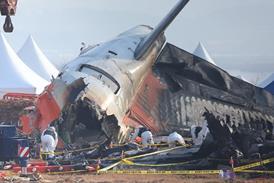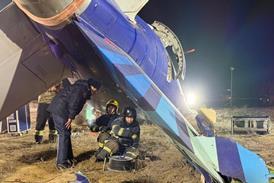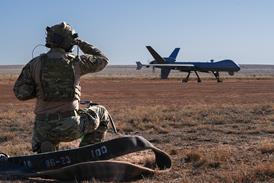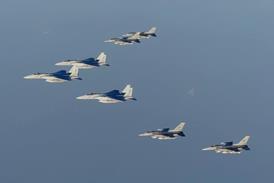One of the most critical missions for business aviation is disaster recovery – and the example of two Caribbean companies in 2017 shines a light on how companies should best prepare for disaster.
Bohlke International Airways and Jet Aviation San Juan’s achievements in dealing with Hurricanes Irma and Maria shows the way towards effective disaster preparedness and recovery – so much so that they were awarded the Sapphire Pegasus Business Aviation Award for their efforts. This recognises the achievements of the dedicated men and women who work in business aviation – people who, as the hurricanes approached, found themselves dealing with humanitarian issues that stretched them to their limits.
Imagine, for instance, you are responsible for more than 100 medical evacuation sorties of critically ill patients. In the run-up to Hurricanes Irma and Maria and their 105-day-long aftermath, Bohlke flew more than 160,000km (99,400 miles) on medevac missions. It carried these out without one loss, while fielding calls from worried families from around the world hoping for news of their afflicted relatives.
Or imagine your FBO is one of the few surviving structures after a disaster, becoming the sole centre for the delivery of humanitarian and government relief. It is the only customs and border protection facility on Puerto Rico, and the main port of entry for both maritime and air traffic. When their operations in the wake of the hurricanes were over, Jet Aviation’s FBO had processed more than 3,100 humanitarian flights, 25,000 passengers, 2,000 critical-care patients, 20,000 tonnes of cargo and 2,000 pets.
Team preparations
Bohlke and Jet Aviation were embedded in the multi-agency emergency preparedness effort for Hurricanes Irma and Maria, which included FAA, FEMA, local governments, police, airport authorities and the departments of Defense, Homeland Security and Health & Human Services. Bohlke also dealt with the British military for the British Virgin Islands, while Jet Aviation’s team included the Department of State, Customs and Border Protection and the Transport Security Association (TSA).
“In other words, we did not do this alone,” says Bohlke’s chief executive Billy Bohlke, the third generation of his family to lead the company. “We had 20 solid days of emergency response – and one lesson we learned was you have to prepare your business and your employees for this gruelling pace. You can pre-deploy five to seven days of supplies, but you also have to have a logistics supply chain to re-supply.”
AeroMD president and chief medical officer Dr Brendan Anzalone points to the importance of employee briefings. “It was important for both information provided to our employees, and for intelligence gathering in terms of what needed to be done,” he says. “It’s like planning a wedding for 40 people in 24 hours.”
The two companies started well before the hurricanes, and continued long after blue skies returned. In the event, Irma’s 185mph (300km/h) winds were merely a dress rehearsal for Maria – a direct hit.
Hector Vasquez, Jet Aviation’s assistant manager of FBO training, and Frances Ryan, the company’s marketing and communications manager, were fortunate because the newly-built, all-glass FBO facility, which opened only 55 days ahead of Hurricane Irma, survived intact – unlike most structures at San Juan’s Luis Muñoz Marín International Airport. However, its 560m2 (6,000ft2) hangar was wiped out by Maria.
Jet Aviation pulled out all the stops to get medicine, power, personnel, supplies and equipment in place to provide the relief the region needed.
St. Croix-based Bohlke suffered a similar fate, although the destruction was even more extensive. It managed to survive the 18h Irma raked the region, only to see its facilities, including its newly-developed Tactical Operations Center (TOC), wiped away by Maria.
“We lost our hangar and the command post. Our assets were all gone. We had to recover fast,” says Bohlke.
“This was a once-in-a-decade event. It turned into two Category 4-5 hurricanes within days of each other,” Anzalone says. “In between, we had to sweat out Hurricane Jose. We knew we’d be literally fueling the airlift and running the logistics for the transient military aircraft. Irma hit September 6; Jose was headed our way on September 9. Thankfully, it skirted north so we didn’t have to move our aircraft again, but rain flooded our offices.”
“Eleven days later Maria hit. It was a Category 3 as it approached Dominica, and two hours later it was a Category 5. We were pretty certain St. Croix and Puerto Rico would get nailed. ATC was a mess, so it was all VFR.”
Bohlke supplies the lift for AeroMD, so it was natural for him to team with Anzalone, who leads the provision of critical care. They fell back on their military training and Anzalone’s experience of the Haiti earthquake.
“We had six days before Irma to pre-deploy what we needed including fuel, satellite communications, food and water,” Anzalone says. “We had to determine the equipment to not only help the businesses survive, but to communicate and ensure situational awareness. Cell phones were our primary communication; satellite communication the alternate and radios were a contingency. We had to harden the satellite communications against the storms.”
Four days out, Anzalone began ordering from Amazon. “They literally shopped for me and positioned all the equipment so we could pick it up,” he says. “And that was just to take care of communications. We already had a list of what was needed from our military days, and it was just a matter of populating it for this situation.”
Jet Aviation’s preparation was similar. “We addressed the protocols we wanted in place after the hurricane,” says Ryan. “We also reached out to employees, so we knew how to contact them – knew where they were, and what they needed to make it possible for them to come to work. We stocked up on food, water, batteries and anything we needed to operate. We made sure we had the fuel we needed to serve all the recovery activities.”
Eliminate problems
“The biggest pivot we made was making our employees part of the family to eliminate their problems,” said Bohlke. “We were operational within hours of Irma, and within 24h of Maria, after rebuilding our ops center. The transition to our temporary facilities was relatively smooth, taking only three days – but the airport remained closed to commercial traffic until October 5.”
“We were fully up and running within 10 hours of Maria with 80% of our staff reporting for duty,” says Ryan, noting Maria was the strongest hurricane to hit Puerto Rico in more than 80 years. “The biggest and toughest burden on us was the physical and emotional toll on our staff. We still think about the tremendous sense of loss, pain and grief. There was no way to prepare for that in advance.”
Both companies stocked up on staples, especially for employees. Generators, food and water and fuel for cars and generators were among the most critical items needed to ensure employees’ families would be provided for, so workers wouldn’t be worried about what was going on at home. And they needed to keep the supplies coming as the days and weeks passed.
“Every medevac mission to the USA was a resupply mission,” says Anzalone. “We even made sure the employees could wash their clothes because they felt better.”
Employees from both companies were severely impacted by the hurricanes, but most reported for duty and worked virtually nonstop through Thanksgiving. Jet Aviation’s staff of 50 employees ballooned as former employees, relatives and friends volunteered to help with everything from directing traffic to playing with children awaiting evacuation. Two immigration lawyers helped untangle the mess created by the evacuation of thousands of people from across the Caribbean to Puerto Rico and then, after Maria, with a second evacuation process.
Continual monitoring
Bohlke moved its Citation Bravo, King Air 200, Gulfstream 100 and MU-2 Marquis out of the hurricanes’ path to Curaçao – but it needed to decide who to take on the five aircraft that were headed back to Curaçao. The answer was to fly as many trips as possible.
“We were speaking to the airport, continually monitoring when it would close, so we knew when to evacuate the aircraft,” Bohlke says. “We were also continually getting intelligence from the US hurricane hunters who operate from our airport. Irma achieved 185mph winds, which was much higher than Andrew, Charley, Katrina and Harvey. Barbuda, St. Maarten and St. Barts nearly got wiped off the map, but we had to ensure business continuity.”
“Irma was the perfect advance planning,” Ryan says. “She didn’t hit Puerto Rico as severely as other islands, but the tower was not operable and most terminals were severely damaged. You could land, but there were no gates or baggage facilities and they had no power, water or communications. But our new FBO building was nearly intact. We had air conditioning, running water, computers and limited internet. The US customs terminal inside our FBO weathered the storm without a scratch. It was fully operational within hours, becoming the main customs and immigration for the region.”
Jet Aviation became the centre for air operations and global humanitarian relief efforts, handling all types of aircraft from 737s to 767s, C-130s, P-3 radar aircraft, rescue helicopters, corporate jets, air ambulances, cargo aircraft and Samaritan’s Purse DC-8s. Supplies and aid were distributed throughout the Caribbean by helicopters and small turboprops, as many airports were completely shut down.
“Our FBO became a major airport,” Ryan says. “We became a collection centre for supplies and donations from major non-profit organisations. That included HIMA, a local health company, which had nine hospitals severely impacted throughout the Caribbean. Supplies included everything from shoes, clothing, medical support, first aid, personal hygiene, baby items, non-perishable food and water. People arrived here for help with the clothes on their back and a plastic bag, with only meagre belongings.”
Ten days after Irma and two days before Maria, both companies were exhausted.
“The people of Puerto Rico had prepared for Irma and got relief to neighbour islands – but we were out of most essentials when Maria showed up,” says Ryan. “We scoured the stores but there was nothing. We had to quadruple our supplies and inventory rapidly. We knew it was not going to be just a few days. We needed power generation. We needed non-perishable goods. We contacted several catering companies immediately after Maria to provide employees with meals. We were operating 24 hours a day for 90 days. It was an extraordinary effort.”
Maria’s aftermath
“No power, no cell, no internet, no air conditioning – and it was going to be that way for some time,” Bohlke says of the first reports from home after Maria.
“The question whether we should try to set up elsewhere was quickly answered,” says Anzalone. “We were going home because we had a responsibility to our community. This was the largest natural disaster known to man, and it occurred in our home town. The storms damaged the core of our business and personal lives. Our employees and the sick and injured were counting on us.”
They found an undamaged building across the airfield from their demolished office, but they needed a generator. “The military delivered a massive generator but we had to figure out how to wire it,” says Bohlke. “The Air Force got us going. Most generators are designed to run a few days to a week, not 120 days. So every 30 days we had to break them down for maintenance, because the generator repair guy was not going show up. The cars we had were no good for post-hurricane hauling, so we got pickup trucks. In terms of internet access, we found we depended too much on local servers for everything from invoicing to fuel ordering. You have to have a contingency. We are moving our servers to the cloud.”
Last sandbags
As Maria approached, Jet Aviation employees were already two hours past the time when they should have been home.
“We were placing the last sandbags and securing protective covers when the police superintendent’s office called to say we couldn’t leave,” says Ryan. “Puerto Rico had received thousands of patients from all over the Caribbean and there was no more room. Ninety-seven dialysis patients had been evacuated to the convention center and now they had to be relocated to Florida because they were afraid after the hurricane there’d be no way to evacuate critically ill patients. We worked with a skeleton crew to get them out. It was scary going home, because Maria was so widespread the winds were really fierce.”
Ryan recalls the nightmare of dealing with so many Caribbean nationalities. “We had to co-ordinate with the Department of State and embassies of other countries,” she says. “Many were worried about being able to return. The volunteer lawyers were able to answer a lot of their questions.”
While pre-planning was key to successful post-disaster operations and numerous lessons were learned, both companies said the right mindset was their most important asset.
“At the end of it all, what we truly believe is that our staff demonstrated the resiliency and generosity of people,” says Ryan, speaking for both companies. “They drove the relief efforts on the island and the Caribbean. We could not have done what we did without them.”
Source: Flight Daily News


























